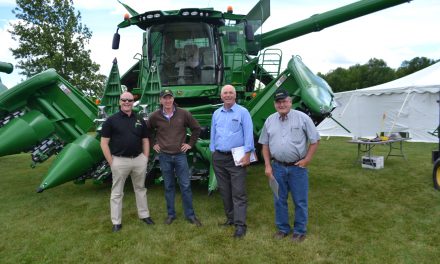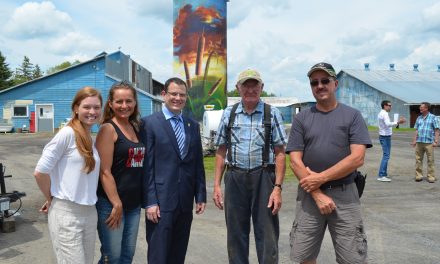Derek Weidhaas of White Pine Bison says watching the herd is his zen. Courtesy photo, Janice L. Bell
by Holly McFarlane
AgriNews Contributor

For well over one hundred years, ranchers, farmers, and conservationists have been working to ensure the survival of the bison species in Canada and the United States. Millions of bison once roamed the plains and wooded areas of North America, dominating the continent thousands of years ago.
Over time, their numbers dwindled as European settlers began building villages, slowly diminishing their natural habitat. Bison played an important role in the settlers’ survival, providing a primary source of food, shelter, and fuel. Unrestricted hunting contributed to a further decrease and near extermination of the bison.
Two different species of bison are native to North America: Plains Bison and Wood Bison. According to the Canadian Bison Association, as of Jan. 1, 2017, there were almost 400,000 bison in North America in tribal and ranched herds. In Canada, as of Jan. 1, 2017, it is estimated that there were about 975 bison producers who owned almost 145,000 bison.
Derek Weidhaas of Pembroke, Ont., is building his future on farming bison as he prepares to retire from full-time service in the Canadian Forces in February 2021. Originally from Kirkland Lake, Ont., Weidhaas joined the military in Sault Ste. Marie in 1994. He has worked as a mobile support equipment operator, air brake instructor, driver instructor/examinor, and defensive driving instructor, to name a few.
In 2006, Weidhaas was posted to Garrison Petawawa. The following year he purchased the 105-acre farm where he currently resides. The farm offered a land base that was less than adequate for farming, with little promise of successfully growing crops or sustaining livestock. With no previous agriculture experience, Weidhaas embraced the challenges that lay before him and began to work at improving the soil quality by tile draining two fields.
“I purchased this farm having zero agriculture experience. Soil and nutrient management is something I am learning as I go!” says Weidhaas. “I completed the Environmental Farm Plan, Grow Your Farm Profits and Biosecurity courses and now am eligible to apply for grants to help further develop the infrastructure on-farm.”
The labour-intensive process of retrofitting the farm has been an ongoing project in any spare time Derek has. To safely contain bison, 1.8-m, high-tensile fences are required. Specialized handling systems and squeeze chutes are designed to safely facilitate the handling of bison.
Establishing the herd
White Pine Bison was officially established in 2019. Weidhaas connected with Bison du Nord, a well-respected bison farm in Earlton, Ont., to purchase his first Plains Bison breeding stock consisting of one bull and three heifers. Weidhaas will continue to expand his herd, seeking out future genetics in Saskatchewan and Alberta.
Plains Bison are naturally found in the North American plains, including Western Canada, Colorado, and Montana. As a member of the Canadian Bison Association, White Pine Bison must adhere to the code of practice outlined for all members. The association provides a wide array of resources for both new and seasoned bison producers, promoting and teaching safe handling techniques and proper practices.
Weidhaas’ herd is 100 per cent natural and grass-fed, currently pastured in a 3.2-ha (8-acre) pen throughout the year, supplemented with dry grass hay in the winter months. The primary objective of White Pine Bison will be to produce safe, quality meat products for the local market, including the base at CFB Petawawa, as early as this spring. Bison, on average, require two to three years to reach market weight. Adult males range in size, averaging 460-990 kg, while females average 360-540 kg. They yield a sought-after, lean meat that is shown to have a great concentration of iron, zinc and essential fatty acids when compared to other meat sources. It offers numerous health benefits when compared to other meats on the market, according to the Canadian Bison Association.
Wild nature
Still exhibiting the strong natural instincts associated with the species, the “wild” nature characterized by bison requires specialized handling methods and skills to ensure the safety of both the bison and their handlers. “With a high flight instinct, the bison are best handled in a chute squeeze that is in a quiet, shaded area to avoid spooking the animals. Despite their flighty tendency, they are remarkably easy to work with when being corralled,” Weidhaas explains.
Bison have retained their natural ability to require minimal intervention with regards to their health and calve successfully without any assistance from humans. Renowned for their efficiency, bison are extremely hardy and thrive in even the coldest of conditions without housing, requiring less intensive management in comparison to their other bovine counterparts. As a result, the Canadian Bison Association indicates that feed and machinery input costs are drastically reduced when raising bison, making them a very sustainable pursuit in agriculture.
Weidhaas continues to plan the development of infrastructure on the farm to include a new barn/shed for hay and equipment storage, a garage/shop, the construction of larger/additional bison pens and the addition of a gravity-fed livestock watering system in the fields. The ultimate goal is an on-site store for local customers to purchase fresh meat and related products and opening up the farm for agritourism.
“I want to raise and provide local, grass-fed bison meat using sustainable farming practices,” says Weidhaas. “I am currently researching different potential markets and hide tanning courses; we will not let any part of the animal go to waste.”
Weidhaas looks forward to future initiatives such as hosting military family days, bison days and youth workshops to create an environment that will foster learning, exposure to agriculture and an opportunity to appreciate the rich heritage of the Plains Bison. “A veteran myself, I want to work toward helping other veterans out in the future by offering a place where they can experience agriculture and help out on the farm. Veterans pursuing work in agriculture is something that you don’t typically see following retirement in the military.”
With retirement on the horizon and the future of White Pine Bison before him, Weidhaas looks forward to growing his herd of bison. “I head out to the fields to check the bison and top up water troughs two to three times a day. I often just stop and admire them. Watching them eat is my zen… they are magical.”
White Pine Bison is very active on social media and can be found on Facebook and Instagram. For more information on the history of bison, bison products or farming practices, visit the Canadian Bison Association at www.canadianbison.ca.













